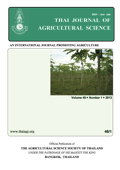Comparisons of Genetic Response of Different Mating Schemes for Improvement of Feed Efficiency, Growth Rate and Percent Lean in Swine
Main Article Content
Abstract
The objective of this study was to compare selection response on three traits (feed conversion ratio, FCR; days to market weight, DAY; and percentage lean content, PCL) based on three mating schemes together with mating criteria for inbreeding control: random mating (RAN), positive assortative mating (AM+), and negative assortative mating (AM-). Only matings that produced less than 10% inbreeding in the offspring would be allowed. Multi-trait animal model simulation software was used for generating pedigree and phenotypes of all traits. The 150 mating pairs from three schemes were selected from current and previous generation animals on their terminal line index (TLI). The results showed that the use of mate selection software could efficiently improve genetic response of FCR, PCL and DAY while controlling inbreeding. All three mating schemes can be applied to improve the genetic response of all growth traits. The AM- gave a slower response, minimum rate of inbreeding, and the most uniformity in offspring phenotypes. However, our result suggested the AM+ accelerated the rate of genetic responses while inbreeding in the population was still in the controlled level. The results of this study have a commercial benefit and could be applied in swine genetic evaluation program with mating selection strategies.


